tow HONDA PRELUDE 1992 Owner's Manual
[x] Cancel search | Manufacturer: HONDA, Model Year: 1992, Model line: PRELUDE, Model: HONDA PRELUDE 1992Pages: 225, PDF Size: 2.1 MB
Page 179 of 225
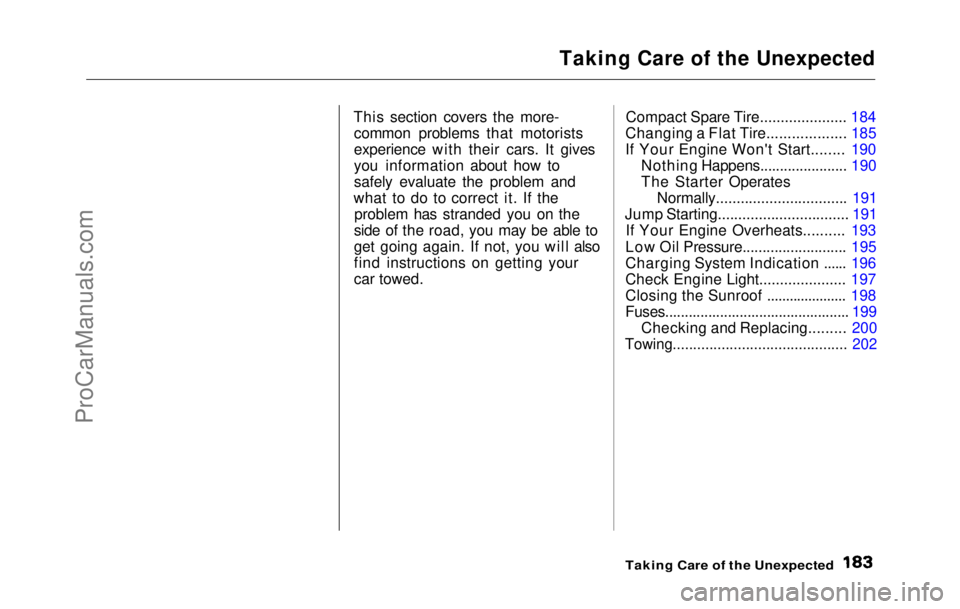
Taking Care of the Unexpected
This section covers the more- common problems that motorists
experience with their cars. It gives
you information about how to
safely evaluate the problem and
what to do to correct it. If the problem has stranded you on the
side of the road, you may be able to
get going again. If not, you will also
find instructions on getting your
car towed. Compact Spare Tire..................... 184
Changing a Flat Tire................... 185
If Your Engine Won't Start........ 190 Nothing Happens...................... 190
The Starter OperatesNormally................................ 191
Jump Starting................................ 191 If Your Engine Overheats.......... 193
Low Oil Pressure.......................... 195
Charging System Indication ...... 196
Check Engine Light..................... 197
Closing the Sunroof ..................... 198
Fuses............................................... 199 Checking and Replacing.........
200
Towing...........................................
202
Taking Car e
of the UnexpectedProCarManuals.comMain Menu s t
Page 186 of 225
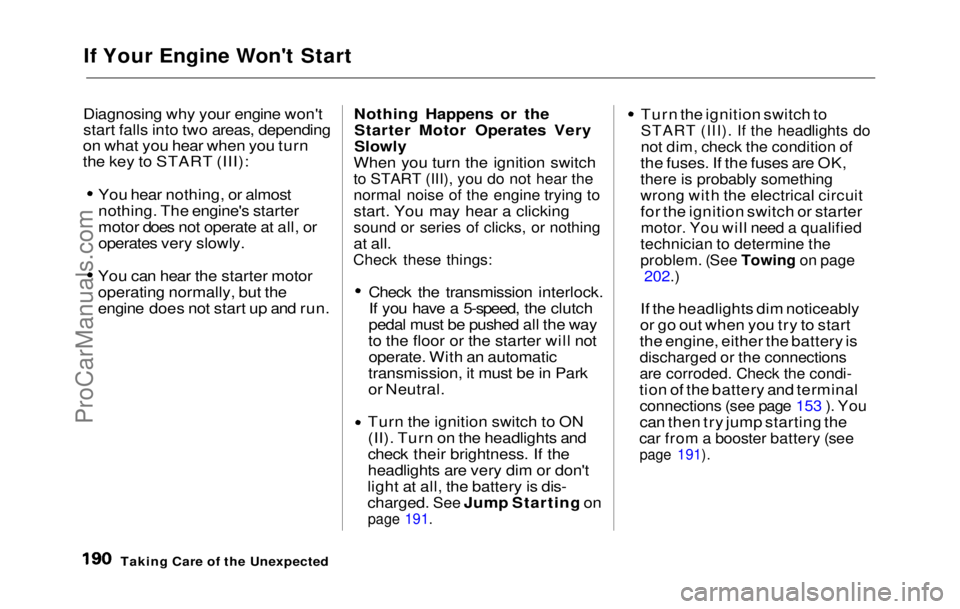
If Your Engine Won't Start
Diagnosing why your engine won't
start falls into two areas, depending
on what you hear when you turn
the key to START (III): You hear nothing, or almost
nothing. The engine's starter
motor does not operate at all, or
operates very slowly.
You can hear the starter motor
operating normally, but the
engine does not start up and run. Nothing Happens or the
Starter Motor Operates Very
Slowly
When you turn the ignition switchto START (III), you do not hear the
normal noise of the engine trying to
start. You may hear
a clicking
sound or series of clicks, or nothing
at all.
Check these things:
Check the
transmission interlock.
If you have a 5-speed, the clutch
pedal must be pushed all the way
to the floor or the starter will not operate. With an automatic
transmission, it must be in Park
or Neutral.
Turn the ignition switch to ON
(II). Turn on the headlights and
check their brightness. If the
headlights are very dim or don't
light at all, the battery is dis-
charged.
See Jump Starting on
page 191
.
Turn the ignition switch to
START (III). If the headlights do
not dim, check the condition of
the fuses. If the fuses are OK,
there is probably something
wrong with the electrical circuit
for the ignition switch or starter
motor. You will need a qualified
technician to determine the
problem. (See Towing on page
202.)
If the headlights dim noticeably
or go out when you try to start
the engine, either the battery is
discharged or the connections
are corroded. Check the condi-
tion of the battery and terminal
connections (see page 153 ). You
can then try jump starting the
car from a booster battery (see
page 191).
Taking Care of the UnexpectedProCarManuals.comMain Menu Table of Contents s t
Page 187 of 225
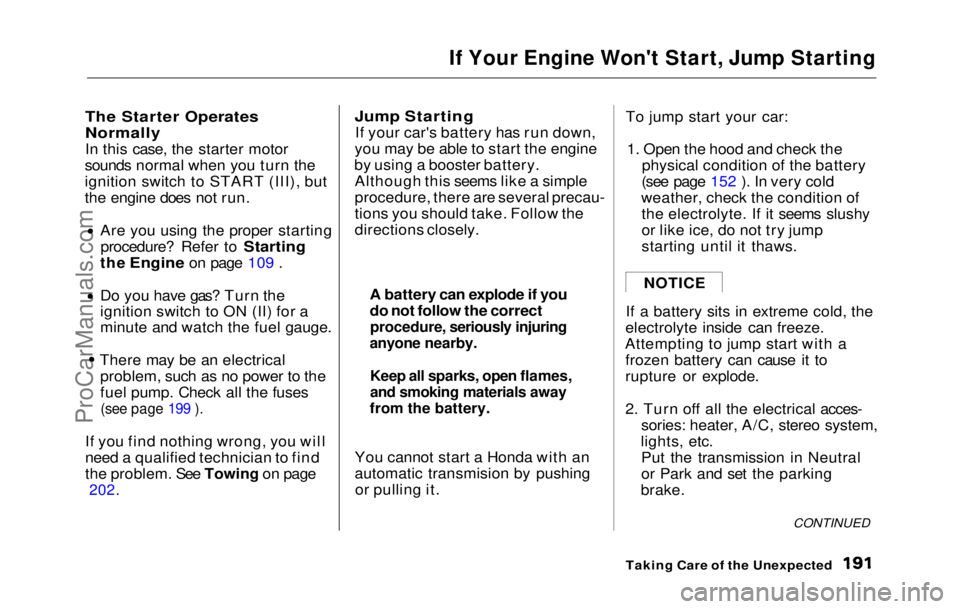
If Your Engine Won't Start, Jump Starting
The Starter Operates
Normally
In this case, the starter motor
sounds normal when you turn the
ignition switch to START (III), but
the engine does not run. Are you using the proper starting
procedure? Refer to Starting
the Engine on page 109 . Do you have gas? Turn the
ignition switch to ON (II) for a
minute and watch the fuel gauge.
There may be an electrical
problem, such as no power to the
fuel pump. Check all the fuses
(see page 199 ).
If you find nothing wrong, you will
need a qualified technician to find
the problem. See Towing on page
202.
Jump Starting
If your car's battery has run down,
you may be able to start the engine
by using a booster battery. Although this seems like a simple
procedure, there are several precau-
tions you should take. Follow the
directions closely.
You cannot start a Honda with an
automatic transmision by pushingor pulling it. To jump start your car:
1. Open the hood and check the physical condition of the battery
(see page 152 ). In very cold
weather, check the condition of the electrolyte. If it seems slushy
or like ice, do not try jump
starting until it thaws.
If a battery sits in extreme cold, the
electrolyte inside can freeze.
Attempting to jump start with a frozen battery can cause it to
rupture or explode.
2. Turn off all the electrical acces- sories: heater, A/C, stereo system,
lights, etc. Put the transmission in Neutral
or Park and set the parking
brake.
Taking Care of the Unexpected
CONTINUED
A battery can explode if you
do not follow the correct
procedure, seriously injuring
anyone nearby.
Keep all sparks, open flames,
and smoking materials away
from the battery.
NOTICE
ProCarManuals.comMain Menu Table of Contents s t
Page 190 of 225
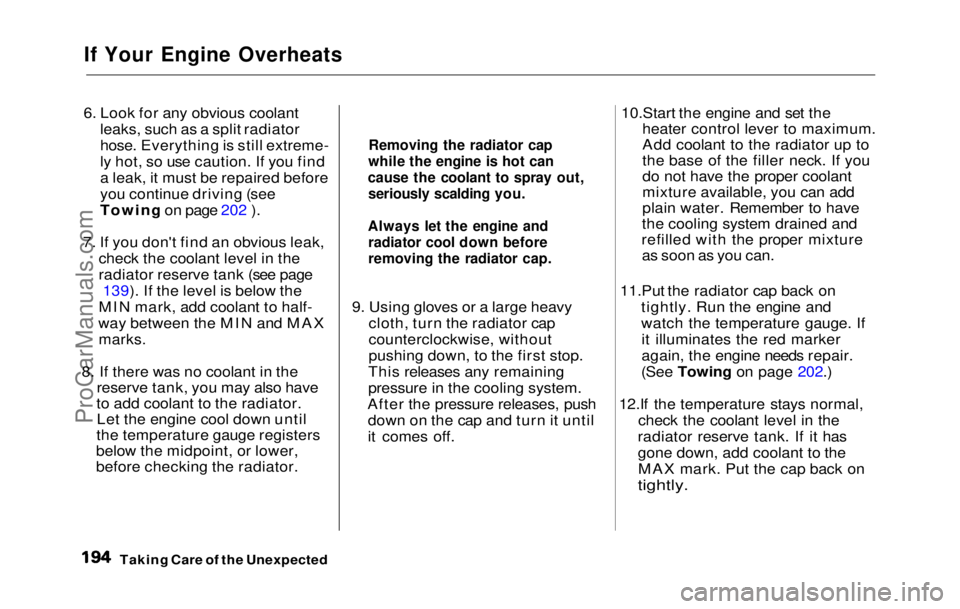
If Your Engine Overheats
6. Look for any obvious coolant
leaks, such as a split radiator
hose. Everything is still extreme-
ly hot, so use caution. If you find
a leak, it must be repaired before
you continue driving (see
Towing on page 202 ).
7. If
you don't find an obvious leak,
check the coolant level in the
radiator reserve tank (see page
139). If the level is below the
MIN mark, add coolant to half-
way between the MIN and MAX
marks.
8. I f
there was no coolant in the
reserve tank, you may also have
to add coolant to the radiator. Let the engine cool down until
the temperature gauge registers
below the midpoint, or lower,
before checking the radiator. 9. Using gloves or a large heavy
cloth, turn the radiator cap
counterclockwise, without
pushing down, to the first stop.
This releases any remaining
pressure in the cooling system.
After the pressure releases, push down on the cap and turn it until
it comes off.
10.Start th e
engine and set the
heater control lever to maximum.
Add coolant to the radiator up to
the base of the filler neck. If you
do not have the proper coolant
mixture available, you can add
plain water. Remember to have
the cooling system drained and
refilled with the proper mixture as soon as you can.
11.Put the radiato
r cap back on
tightly. Run the engine and
watch the temperature gauge. If
it illuminates the red marker
again, the engine needs repair.
(See Towing on page
202.)
12.If th e
temperature stays normal,
check the coolant level in the
radiator reserve tank. If it has
gone down, add coolant to the MAX mark. Put the cap back on
tightly.
Taking Care of the Unexpected
Removing the radiator cap
while the engine is hot can
cause the coolant to spray out, seriously scalding you.
Always let the engine and radiator cool down before
removing the radiator cap.ProCarManuals.comMain Menu Table of Contents s t
Page 191 of 225
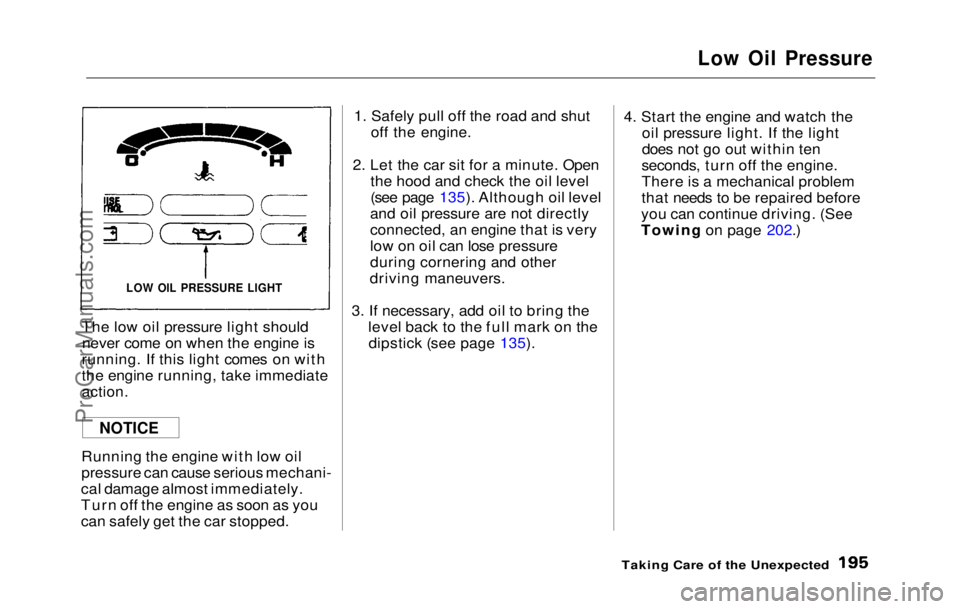
Low Oil Pressure
The low oil pressure light should never come on when the engine is
running. If this light comes on with
the engine running, take immediate
action.
Running the engine with low oil
pressure can cause serious mechani-
cal damage almost immediately.
Turn off the engine as soon as you
can safely get the car stopped. 1. Safely pull off the road and shut
off the engine.
2. Le
t
the car sit for a minute. Open
the hood and check the oil level
(see page 135). Although oil level
and oil pressure are not directly
connected, an engine that is very
low on oil can lose pressure
during cornering and other
driving maneuvers.
3. I f
necessary, add oil to bring the
level back to the full mark on the
dipstick (see page 135
).
4. Star t
the engine and watch the
oil pressure light. If the light
does not go out within ten
seconds, turn off the engine.
There is a mechanical problem
that needs to be repaired before
you can continue driving. (See
Towin g on
page 202 .
)
Taking Car e
of the Unexpected
LOW OIL PRESSURE LIGHT
NOTICEProCarManuals.comMain Menu Table of Contents s t
Page 198 of 225
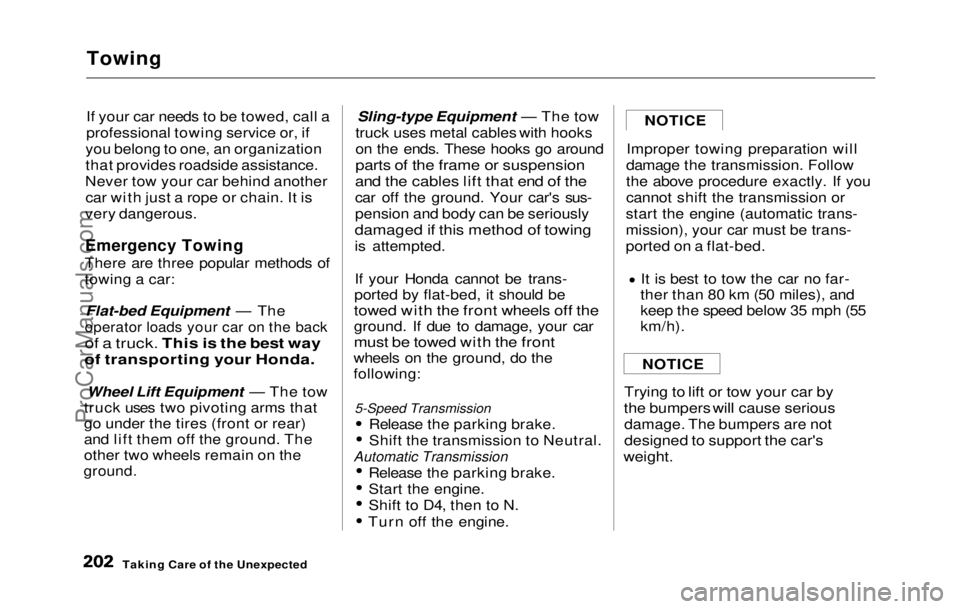
Towing
If your car needs to be towed, call a
professional towing service or, if
you belong to one, an organization
that provides roadside assistance.
Never tow your car behind another car with just a rope or chain. It is
very dangerous.
Emergency Towing
There are three popular methods of
towing a car:
Flat-bed Equipment — The
operator loads your car on the back
of a truck. This is the best way
of transporting your Honda.
Wheel Lift Equipment — The tow
truck uses two pivoting arms that
go under the tires (front or rear)
and lift them off the ground. The
other two wheels remain on the
ground.
Sling-type Equipment — The tow
truck uses metal cables with hooks
on th
e
ends. These hooks go around
parts of the frame or suspension
and the cables lift that end of the
car off the ground. Your car's sus-
pension and body can be seriously
damaged if this method
of towing
is attempted.
If your Honda cannot be trans-
ported by flat-bed, it should be
towed with the front wheels off the
ground. If due to damage, your car
must be towed with the front
wheels on the ground, do the
following:
5-Speed Transmission
Release the parking brake.
Shift the transmission to Neutral.
Automatic Transmission
Release the parking brake.
Start the engine.
Shift to D4, then to N.
Turn off the engine. Improper towing preparation will
damage the transmission. Follow
the above procedure exactly. If you
cannot shift the transmission or
start the engine (automatic trans-
mission), your car must be trans-
ported on a flat-bed. It is best to tow the car no far-
ther than 80 km (50 miles), and
keep the speed below 35 mph (55
km/h).
Trying to lift or tow your car by
the bumpers will cause serious
damage. The bumpers are not
designed to support the car's
weight.
Taking Care
of the Unexpected NOTICE
NOTICEProCarManuals.comMain Menu Table of Contents s t
Page 213 of 225
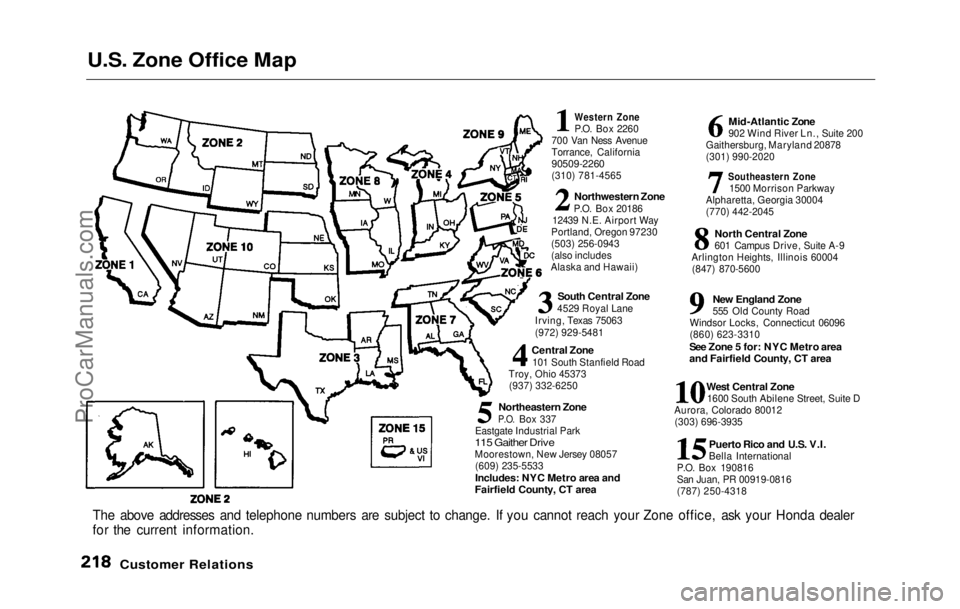
U.S. Zone Office Map
Western Zone
P.O. Box 2260
700 Van Ness Avenue
Torrance, California
90509-2260
(310) 781-4565
Northwestern Zone
P.O. Box 20186
12439 N.E. Airport Way
Portland, Oregon 97230
(503) 256-0943
(also includes
Alaska and Hawaii)
South Central Zone
4529 Royal Lane
Irving, Texas 75063
(972) 929-5481
Central Zone
101 South Stanfield Road
Troy, Ohio 45373 (937) 332-6250
Northeastern Zone
P.O.
Box 337
Eastgate Industrial Park
115 Gaither Drive
Moorestown, New Jersey 08057 (609) 235-5533
Includes: NYC Metro area and
Fairfield County, CT area
Mid-Atlantic Zone
902 Wind River Ln., Suite 200
Gaithersburg, Maryland 20878
(301) 990-2020
Southeastern Zone
1500 Morrison Parkway
Alpharetta, Georgia 30004
(770) 442-2045
North Central Zone
601 Campus Drive, Suite A-9
Arlington Heights, Illinois 60004 (847) 870-5600
New England Zone
555 Old County Road
Windsor Locks, Connecticut 06096
(860) 623-3310
See Zone 5 for: NYC Metro area
and Fairfield County, CT area
West Central Zone
1600 South Abilene Street, Suite D
Aurora, Colorado 80012 (303) 696-3935
Puerto Rico and U.S. V.I.
Bella International
P.O. Box 190816
San Juan, PR 00919-0816
(787) 250-4318
The above addresses and telephone numbers are subject to change. If you cannot reach your Zone office, ask your Honda dealer
for the current information.
Customer RelationsProCarManuals.comMain Menu Table of Contents s t
Page 219 of 225
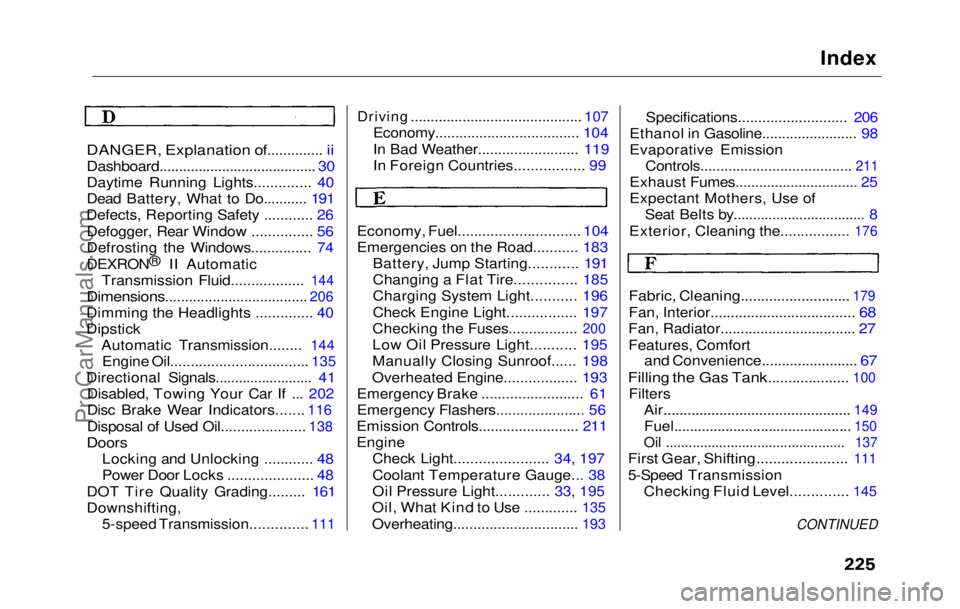
Index
DANGER, Explanation of.............. ii
Dashboard........................................ 30
Daytime Running Lights.............. 40
Dead Battery, What to Do........... 191
Defects, Reporting Safety ............ 26
Defogger, Rear Window ............... 56
Defrosting the Windows............... 74
DEXRON ®
II Automatic
Transmission Fluid.................. 144
Dimensions.................................... 206
Dimming the Headlight
s .............. 40
Dipstick Automatic Transmission........
144
Engine Oil................................. .
135
Directional Signals........................
.
41
Disabled, Towing Your Car If ... 202
Disc Brake Wear Indicators.......
116
Disposal o f
Used Oil.....................
138
Doors
Locking an
d Unlocking ............ 48
Power Door Locks ..................... 48
DOT Tire Quality Grading......... 161
Downshifting,
5-speed Transmission.............. 111
Driving .......................................... .
107
Economy.................................... 104
In Bad Weather......................... 119
In Foreign Countries................. 99
Economy, Fuel.............................. 104
Emergencies on the Road........... 183 Battery, Jump Starting............ 191
Changing a Flat Tire............... 185
Charging System Light........... 196
Check Engine Light................. 197
Checking the Fuses.................
200
Low Oi l
Pressure Light........... 195
Manually Closing Sunroof...... 198
Overheated Engine.................. 193
Emergency Brake ......................... 61
Emergency Flashers...................... 56
Emission Controls......................... 211
Engine Check Light....................... 34, 197
Coolant Temperature Gauge... 38
Oil Pressure Light............. 33, 195
Oil, What Kind to Use .............
135
Overheating............................... 193
Specifications........................... 206
Ethano l
in Gasoline........................ 98
Evaporative Emission Controls......................................
211
Exhaust Fumes.............................. .
25
Expectant Mothers, Use of Seat Belts by.................................. 8
Exterior, Cleaning the.................
176
Fabric, Cleaning........................... 179
Fan, Interior.................................... 68
Fan, Radiator.................................. 27
Features, Comfort
and Convenience........................ 67
Filling the Gas Tank.................... 100
Filters
Air
............................................... 149
Fuel............................................. 150
Oil ............................................... 137
First Gear, Shifting...................... 111
5-Speed Transmissio n
Checkin
g Fluid Level..............
145
CONTINUED
ProCarManuals.comMain Menu s t
Page 220 of 225
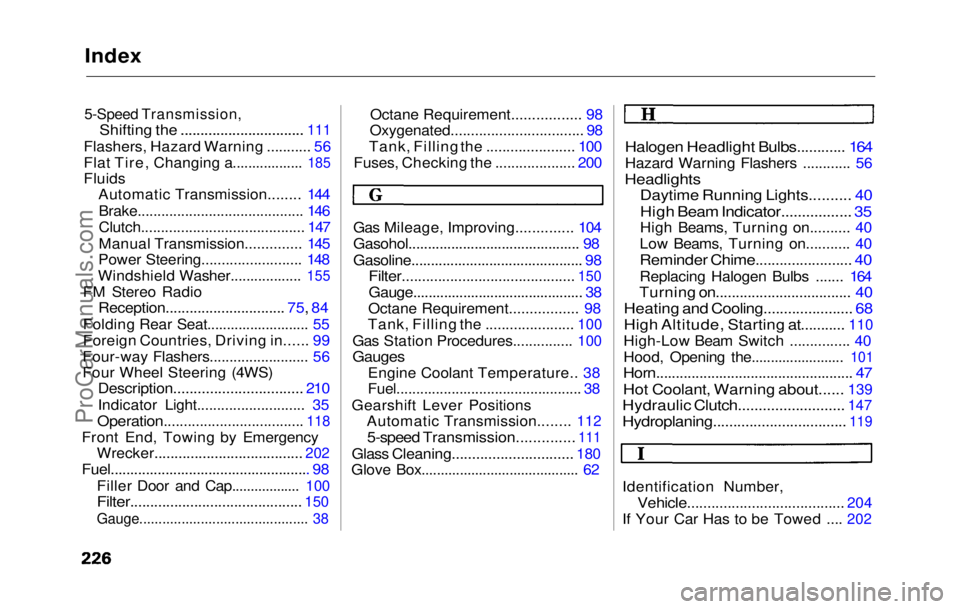
Index
5-Speed Transmission,
Shifting the ............................... 111
Flashers, Hazard
Warning ........... 56
Flat Tire, Changing a..................
185
Fluids Automatic Transmission.......
. 144
Brake.......................................... 146
Clutch......................................... 147
Manual Transmission.............. 145
Power Steering......................... 148
Windshield Washer..................
155
FM Stereo
Radio
Reception.............................. 75, 84
Folding Rear Seat.......................... 55
Foreign Countries, Driving in...... 99
Four-way Flashers......................... 56
Four Wheel Steering (4WS)
Description................................ 210
Indicator Light........................... 35
Operation...................................
118
Front End ,
Towing by Emergency
Wrecker..................................... 202
Fuel................................................... 9
8
Fille
r Door and Cap..................
100
Filter........................................... 150
Gauge............................................ 3
8
Octan
e Requirement................. 98
Oxygenated................................. 98
Tank, Filling the ...................... 100
Fuses, Checking the .................... 200
Gas Mileage, Improving.............. 104
Gasohol............................................ 98
Gasoline............................................ 98
Filter...........................................
150
Gauge............................................ 3 8
Octan
e Requirement................. 98
Tank, Filling the ......................
100
Gas Statio n
Procedures...............
100
Gauges
Engine Coolan
t Temperature.. 38
Fuel............................................... 38
Gearshift Lever Positions Automatic Transmission........
112
5-speed Transmission............. .
111
Glass Cleaning.............................
.
180
Glove Box........................................
.
62
Halogen Headlight Bulbs............ 164
Hazard Warning Flashers ............ 56
Headlights
Daytime Running Lights.......... 40
High Beam Indicator................. 35
High Beams, Turning on.......... 40
Low Beams, Turning on........... 40
Reminder Chime........................ 40
Replacing Halogen Bulbs ....... 164
Turning on.................................. 40
Heating and Cooling...................... 68
High Altitude, Starting at...........
110
High-Low Bea m
Switch ............... 40
Hood, Opening the........................
101
Horn.................................................. 4 7
Ho
t Coolant, Warning about......
139
Hydraulic Clutch.........................
.
147
Hydroplaning................................. 119
Identification Number
,
Vehicle......................................
.
204
If You
r
Car Has to be Towed ....
202
ProCarManuals.comMain Menu s t
Page 222 of 225
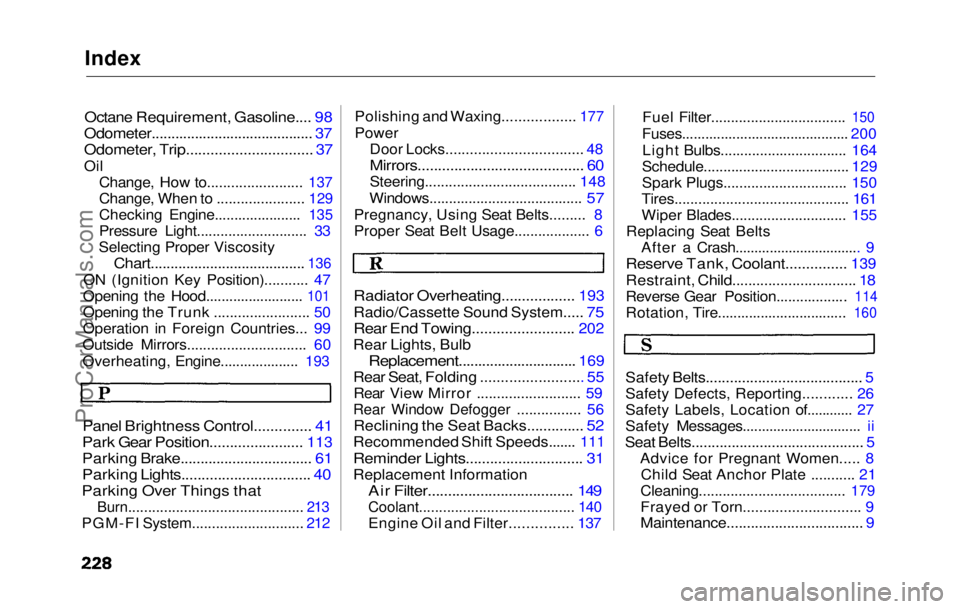
Index
Octane Requirement, Gasoline.... 98
Odometer......................................... 37
Odometer, Trip............................... 37
Oil Change, How to........................ 137
Change, When
to ......................
129
Checking Engine......................
135
Pressure Light............................
33
Selecting Proper Viscosity
Chart.......................................
136
ON (Ignitio n
Key Position)........... 47
Opening the Hood.........................
101
Opening th e
Trunk ........................ 50
Operation in Foreign Countries... 99
Outside Mirrors.............................. 60
Overheating, Engine....................
193
Panel Brightnes s
Control.............. 41
Park Gear Position.......................
113
Parking Brake................................ .
61
Parking Lights................................ 40
Parking Over Things that
Burn............................................ 213
PGM-FI System............................ 212
Polishing and Waxing..................
177
Power
Door Locks.................................
. 48
Mirrors......................................... 60
Steering...................................... 148
Windows.......................................
57
Pregnancy, Usin g
Seat Belts......... 8
Proper Seat Belt Usage................... 6
Radiator Overheating..................
193
Radio/Cassette Sound System
..... 75
Rear En d
Towing.........................
202
Rear Lights, Bulb
Replacement.............................. 169
Rear Seat, Folding ......................... 55
Rear Vie w
Mirror .......................... 59
Rear Window Defogger ................ 56
Reclining the Seat Backs.............. 52
Recommended Shift Speeds....... 111
Reminder Lights............................
.
31
Replacement Information
Air Filter...................................
.
149
Coolant....................................... 140
Engine Oil and Filter............... 137 Fuel Filter..................................
150
Fuses...........................................
200
Ligh
t Bulbs................................ 164
Schedule..................................... 129
Spark Plugs............................... 150
Tires............................................ 161
Wiper Blades............................. 155
Replacing Seat Belts After a Crash................................. 9
Reserve Tank, Coolant...............
139
Restraint, Child.............................. .
18
Reverse Gear Position..................
114
Rotation, Tire............................... ..
160
Safety Belts......................................
.
5
Safety Defects, Reporting............ 26
Safety Labels, Location of............ 27
Safety Messages............................... ii
Seat Belts........................................... 5
Advice for Pregnant Women..... 8Child Seat Anchor Plate ........... 21
Cleaning.....................................
179
Frayed o r
Torn............................. 9
Maintenance.................................. 9ProCarManuals.comMain Menu s t